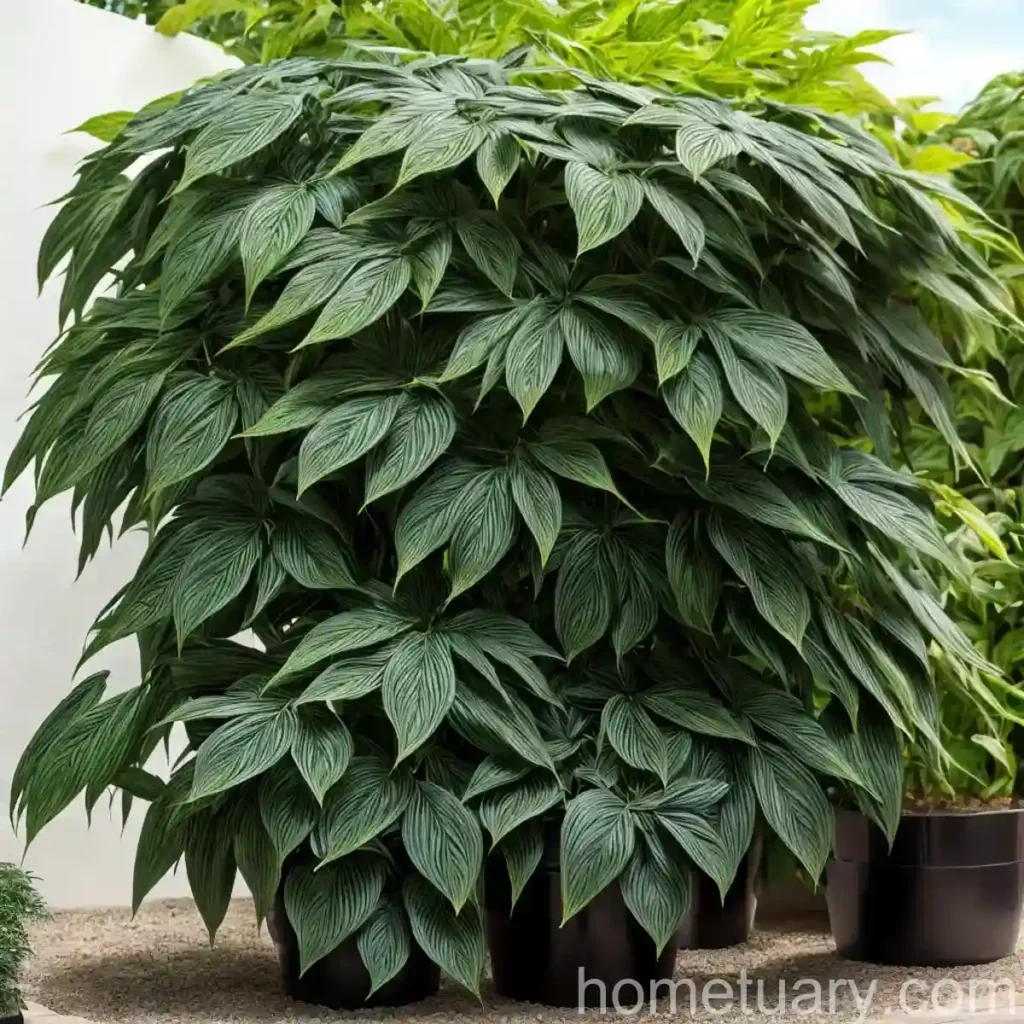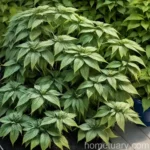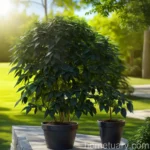Aralia (Eleutherococcus sieboldianus ‘Variegatus’): A Complete Plant Care Guide
Aralia, scientifically known as Eleutherococcus sieboldianus ‘Variegatus’, is a stunning variegated plant that brings a touch of elegance and vibrancy to any garden or indoor space. With its striking foliage and adaptable nature, this plant has gained popularity among plant enthusiasts and gardeners. In this comprehensive plant care guide, we will explore the culture, uses, care requirements, propagation techniques, common diseases and pests, and various other aspects of growing and maintaining Aralia (Eleutherococcus sieboldianus ‘Variegatus’).
What is Aralia (Eleutherococcus sieboldianus ‘Variegatus’)?
Aralia (Eleutherococcus sieboldianus ‘Variegatus’) is a handsome, low-maintenance shrub that belongs to the Araliaceae family. This plant is native to Japan and is admired for its distinctive variegated foliage, which features shades of green and white, adding a touch of visual interest to any landscape or indoor setting. Aralia ‘Variegatus’ is characterized by its upright growth habit and is an excellent choice for adding texture and color to gardens, borders, and container plantings. The plant’s botanical name, Eleutherococcus sieboldianus, pays tribute to the German physician, Philipp Franz von Siebold, who introduced numerous Japanese plants to Europe in the 19th century.
In the following sections, we will delve into the key aspects of Aralia (Eleutherococcus sieboldianus ‘Variegatus’) care, including culture, uses, water, sunlight, fertilizer, soil, pruning, propagation, container planting, as well as common diseases and pests. Whether you are a seasoned gardener or a beginner plant enthusiast, this guide will provide valuable insights into ensuring the healthy growth and longevity of this captivating variegated plant.
Key Takeaways – Aralia (Eleutherococcus sieboldianus ‘Variegatus’)
Before we dive into the specifics of caring for Aralia (Eleutherococcus sieboldianus ‘Variegatus’), let’s take a quick look at the key takeaways for this unique plant:
- Scientific Name: Eleutherococcus sieboldianus ‘Variegatus’
- Family: Araliaceae
- Common Names: Aralia ‘Variegatus’, Variegated Aralia
- Foliage: Variegated, green and white
- Uses: Ornamental, landscaping, indoor display
- Growth Habit: Upright, bushy
- Hardiness Zone: 4-9
- Watering: Regular, moderate moisture
- Sunlight: Partial shade to full sun
- Soil: Well-draining, fertile
- Fertilizer: Balanced, slow-release
- Pruning: Minimal, shaping for aesthetics
- Propagation: Stem cuttings, division
- Common Diseases: Leaf spot, powdery mildew
- Common Pests: Spider mites, aphids
- Additional Benefits: Air-purifying, low maintenance
- Popularity: Growing interest among gardeners
Now that we have an overview of the key characteristics and care requirements of Aralia (Eleutherococcus sieboldianus ‘Variegatus’), let’s explore each aspect in more detail.
Culture
The culture of Aralia (Eleutherococcus sieboldianus ‘Variegatus’) encompasses its preferred growing conditions, seasonal changes, and general care practices that contribute to its overall health and vitality.
Uses
Aralia ‘Variegatus’ is widely valued for its ornamental qualities, making it a versatile addition to various landscape settings and indoor spaces. Some potential uses of Aralia (Eleutherococcus sieboldianus ‘Variegatus’) include:
- Landscaping: The variegated foliage of Aralia ‘Variegatus’ adds visual interest and texture to garden beds, borders, and mixed plantings.
- Container Planting: The plant’s compact size and aesthetic appeal make it an ideal choice for container gardening on patios, decks, and balconies.
- Indoor Display: Aralia (Eleutherococcus sieboldianus ‘Variegatus’) can thrive as a houseplant, adding a touch of greenery and elegance to interior spaces.
Water
Proper watering is essential for maintaining the health and vigor of Aralia (Eleutherococcus sieboldianus ‘Variegatus’). While it is important to ensure an adequate supply of moisture, overwatering should be avoided to prevent waterlogged conditions, which can lead to root rot and other complications. Key points to consider for watering this variegated plant include:
- Moisture: Aralia ‘Variegatus’ benefits from moderate moisture levels, and the soil should be kept consistently moist but not waterlogged. Allow the top inch of the soil to dry out slightly before watering.
- Seasonal Variation: Adjust the watering frequency based on seasonal changes, increasing it during the warmer months and reducing it during the plant’s dormant period in winter.
- Watering Technique: Water the plant thoroughly, allowing the excess water to drain away from the pot or root zone to prevent waterlogging.
Sunlight
Aralia (Eleutherococcus sieboldianus ‘Variegatus’) thrives in partial shade to full sun conditions, making it adaptable to a variety of light environments. Proper sunlight exposure is crucial for the plant’s growth and foliage coloration. Consider the following points related to sunlight requirements for Aralia ‘Variegatus’:
- Light Levels: Provide the plant with partial shade to full sun for optimal growth and vibrant foliage. In indoor settings, place the plant in a location that receives bright, indirect light.
- Morning Sun: In warmer climates, morning sun exposure is beneficial, as it helps the plant utilize sunlight without the intense heat of the afternoon sun.
- Adjusting Light Conditions: Monitor the plant’s response to sunlight and make adjustments as needed. If leaf scorching occurs, consider providing partial shade or filtered light during the hottest part of the day.
Fertilizer
Feeding Aralia (Eleutherococcus sieboldianus ‘Variegatus’) with a balanced fertilizer helps promote healthy growth and foliar development. Selecting the right type of fertilizer and following a consistent feeding schedule can contribute to the plant’s overall vigor and appearance. Consider the following guidelines for fertilizing Aralia ‘Variegatus’:
- Fertilizer Type: Use a balanced, slow-release fertilizer that is suitable for ornamental shrubs. Look for a formulation with equal or near-equal proportions of nitrogen, phosphorus, and potassium.
- Feeding Frequency: Apply fertilizer to the plant in early spring, just before the start of the growing season, and again in mid-summer to provide additional nutrients during active growth.
- Application Method: Distribute the fertilizer evenly around the base of the plant, following the manufacturer’s instructions for the correct application rate. Water the plant after application to facilitate nutrient absorption.
Soil
Choosing the right type of soil and ensuring proper drainage are essential for the well-being of Aralia (Eleutherococcus sieboldianus ‘Variegatus’). The plant thrives in fertile, well-draining soil that provides a conducive environment for root development and nutrient uptake. Consider the following aspects related to soil requirements for Aralia ‘Variegatus’:
- Soil Type: Use a well-draining, loamy soil mix that is rich in organic matter. A mixture of peat moss, compost, and perlite or coarse sand can create an ideal growing medium for Aralia ‘Variegatus’.
- Acidity: The soil pH should be slightly acidic to neutral, in the range of 6.0 to 7.0, to support nutrient availability and root health.
- Drainage: Ensure that the planting site or container provides adequate drainage to prevent waterlogging and root suffocation. Consider adding drainage holes to containers if necessary.
Pruning
Pruning Aralia (Eleutherococcus sieboldianus ‘Variegatus’) involves minimal maintenance and is primarily focused on shaping the plant for aesthetics, removing dead or damaged growth, and managing its size within the desired space. Proper pruning practices contribute to the plant’s overall appearance and longevity. Consider the following guidelines for pruning Aralia ‘Variegatus’:
- Pruning Time: Perform pruning during the plant’s dormant period in late winter or early spring to minimize stress on the plant and promote vigorous regrowth.
- Deadheading: Remove spent flowers and discolored or dead foliage to maintain a tidy and visually appealing appearance.
- Shaping: Trim unruly or leggy growth to maintain a compact and well-balanced form. Focus on preserving the plant’s natural shape while removing any overcrowded or crossing branches.
- Tools: Use clean, sharp pruning shears to make precise cuts and minimize the risk of damaging the plant. Sterilize the pruning tools between uses to prevent the spread of diseases.
Propagation
Propagating Aralia (Eleutherococcus sieboldianus ‘Variegatus’) allows you to expand your plant collection and share this captivating species with fellow gardening enthusiasts. The plant can be propagated through stem cuttings and division, offering opportunities to create new plants with the same attractive variegated foliage. Consider the following techniques for propagating Aralia ‘Variegatus’:
Stem Cuttings
- Selecting Cuttings: Choose healthy, non-flowering stems with several sets of leaves. Each cutting should be approximately 4-6 inches long and include at least two leaf nodes.
- Preparing the Cuttings: Remove the lower set of leaves from the stem cuttings, leaving a clean 2-inch section of the stem exposed. Dip the cut end in rooting hormone to encourage root development.
- Planting the Cuttings: Insert the prepared cuttings into a well-draining rooting medium, such as a mixture of perlite and peat moss. Keep the medium consistently moist and provide warmth and indirect light to promote root formation.
- Establishing Roots: Monitor the cuttings for signs of new growth and root development. Once the cuttings have established a healthy root system, they can be transplanted into individual pots or directly into the garden.
Division
- Based on Plant Size: For larger Aralia (Eleutherococcus sieboldianus ‘Variegatus’) specimens, division can be performed to create new plants. Carefully dig up the plant and separate the root clumps into smaller sections, ensuring that each division has sufficient roots and foliage.
- Replanting Divisions: Plant the divided sections in suitable containers or directly in the garden, ensuring that the planting site provides the appropriate growing conditions for the new plants.
- Watering and Care: Water the newly divided plants thoroughly and monitor their progress as they establish new root systems and acclimate to their new environment.
Container Popularity
Aralia (Eleutherococcus sieboldianus ‘Variegatus’) has gained popularity as a container plant due to its compact size, attractive foliage, and adaptability to container gardening. The plant’s striking variegated leaves make it a valuable addition to various outdoor and indoor container displays. Consider the following aspects related to the popularity of Aralia ‘Variegatus’ for container planting:
- Space Considerations: The plant’s modest size and foliage density make it well-suited for use in containers on patios, balconies, and other small outdoor spaces.
- Visual Impact: The variegated foliage of Aralia ‘Variegatus’ serves as a focal point in container arrangements, providing color contrast and texture.
- Indoor Display: As a houseplant, Aralia (Eleutherococcus sieboldianus ‘Variegatus’) thrives in containers, adding a touch of natural beauty to interior settings while requiring minimal maintenance.
Common Diseases
Aralia (Eleutherococcus sieboldianus ‘Variegatus’) is generally resistant to diseases, but certain environmental conditions or cultural practices may make the plant susceptible to specific issues. Understanding common diseases and their preventive measures is essential for maintaining the plant’s health and vitality. Consider the following common diseases that may affect Aralia ‘Variegatus’:
Leaf Spot
- Symptoms: Dark or light spots on the leaves, often with a yellow halo. These spots may coalesce and result in leaf discoloration and defoliation in severe cases.
- Preventive Measures: Maintain proper air circulation around the plant, avoid overhead watering, and promptly remove and dispose of any infected leaves to prevent the spread of the disease. Consider applying fungicidal treatments if leaf spot becomes a recurring issue.
Powdery Mildew
- Symptoms: White, powdery growth on the upper and lower leaf surfaces, often accompanied by leaf distortion and stunted growth.
- Preventive Measures: Ensure adequate spacing between plants to promote air circulation, keep the foliage dry, and monitor humidity levels. Apply fungicidal sprays preventatively if powdery mildew has been problematic in the past.
Common Pests
While Aralia (Eleutherococcus sieboldianus ‘Variegatus’) is relatively resistant to pest attacks, occasional infestations by common garden pests may occur. Monitoring the plant for signs of pests and promptly addressing any issues helps prevent damage and maintains the plant’s vitality. Consider the following common pests that may affect Aralia ‘Variegatus’:
Spider Mites
- Symptoms: Fine webbing on the plant, yellow stippling on the leaves, and reduced vigor. Spider mites thrive in dry conditions and can reproduce rapidly, leading to widespread damage if left unchecked.
- Control Measures: Increase humidity around the plant, use a strong water spray to dislodge the mites, and consider applying insecticidal soap or neem oil to manage infestations.
Aphids
- Symptoms: Clusters of small, soft-bodied insects on the new growth, often accompanied by sticky honeydew residue and sooty mold development.
- Control Measures: Use a strong stream of water to remove aphids from the plant, introduce beneficial insects such as ladybugs, and consider using insecticidal soap if aphid populations are high.
Botanist’s Tips
As a plant scientist with a passion for Aralia (Eleutherococcus sieboldianus ‘Variegatus’) and its unique attributes, I would like to share some valuable tips for enthusiasts seeking to cultivate and care for this exceptional variegated plant:
- Selecting Planting Location: When choosing a site for planting Aralia ‘Variegatus’, consider the light and soil requirements, ensuring that the plant is positioned in an environment that promotes healthy growth and foliage coloration.
- Consistent Monitoring: Regularly monitor the plant for signs of stress, disease, or pest activity, intervening promptly to address any issues and maintain the plant’s well-being.
- Balanced Watering: Strive to maintain consistent soil moisture, avoiding fluctuations between overly dry and waterlogged conditions. Adjust the watering frequency based on seasonal changes and the plant’s specific needs.
- Prudent Pruning: Exercise caution when pruning Aralia ‘Variegatus’, focusing on the removal of dead or damaged growth and minimal shaping to preserve the plant’s natural form.
- Healthy Propagation: When propagating Aralia (Eleutherococcus sieboldianus ‘Variegatus’) through stem cuttings or division, prioritize the use of healthy plant material and provide optimal conditions for root development and establishment.
Fun Facts
As we marvel at the beauty and resilience of Aralia (Eleutherococcus sieboldianus ‘Variegatus’), let’s explore some captivating and lesser-known facts about this remarkable variegated plant:
- Environmental Adaptability: Aralia ‘Variegatus’ is known for its ability to thrive in diverse environmental conditions, making it an excellent choice for gardens, landscapes, and indoor display.
- Air-Purifying Qualities: Like many other plants, Aralia (Eleutherococcus sieboldianus ‘Variegatus’) contributes to air purification and can help create a healthier indoor environment by removing certain pollutants and promoting better air quality.
- Elegant Foliage: The variegated leaves of Aralia ‘Variegatus’ feature an intricate pattern of green and white, creating a visually striking display that complements various design styles and color schemes.
- Wildlife Interest: The plant’s foliage and berries may attract birds and beneficial insects, adding a touch of wildlife interest to the garden and promoting ecological diversity.
Links to External Resources
To expand your knowledge and access additional information on Aralia (Eleutherococcus sieboldianus ‘Variegatus’) care, propagation, and ornamental uses, I recommend exploring the following external resources:
- The Royal Horticultural Society – Aralia ‘Variegata’
- University of Wisconsin-Madison Extension – Variegated Foliage Plants for the North
- American Phytopathological Society – Common Diseases of Aralia
- University of Florida IFAS Extension – Aralia Pests and Diseases
With the insights provided in this comprehensive plant care guide, you are well-equipped to embark on a rewarding journey of nurturing and enjoying the vibrant beauty of Aralia (Eleutherococcus sieboldianus ‘Variegatus’). Whether adding a touch of elegance to your garden, exploring container planting possibilities, or simply appreciating the benefits of cultivating air-purifying foliage plants, Aralia ‘Variegatus’ offers a delightful and versatile choice for plant enthusiasts of all levels.
Happy gardening!















